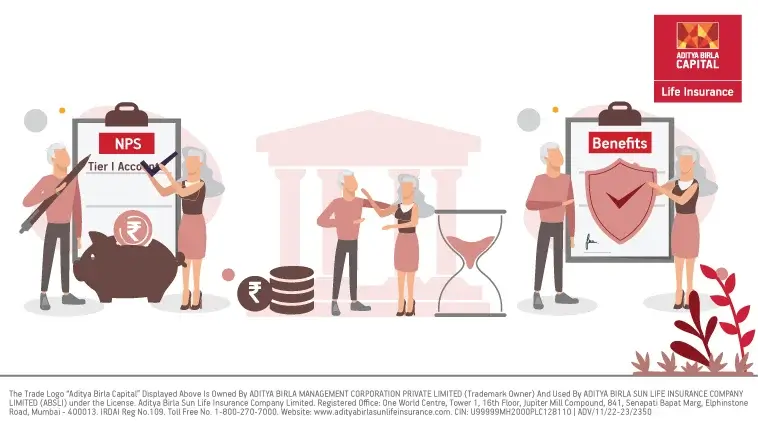Aditya Birla Sun Life Insurance Company Limited
NPS Tier 1 Account: Know the Benefits, Application & Withdrawal Process

Plan Smarter, Live Better!

Thank you for your details. We will reach out to you shortly.

Currently we are facing some issue. Please try after sometime.


- Table of Contents
A rather popular retirement-cum-pension scheme, National Pension System, NPS, offers the investors double benefits. On one hand, it helps them plan their golden years of retirement while on the other hand, it helps them save on taxes. This government-run monetary scheme allows tax savings that can go as high as INR 1.5 lakhs per year. There are two account preferences in NPS - NPS Tier 1 and NPS Tier 2. The most basic form is the NPS Tier 1 account. Let us understand NPS Tier 1 in detail.
What is Tier 1 in NPS?
Under the NPS, the government invests your savings in market-linked funds and thus, offers an inflation-regulated pension that helps you secure your second innings. Meant primarily for retirement savings, in an NPS Tier 1 account, there has to be a minimum ₹500 deposit when opening an account. For an NPS Tier 2, having an NPS Tier 1 account is mandatory.
What are the Features of NPS Tier 1 Account?
To understand the NPS Tier 1 better, let us take a look at its key features:
-
NPS Tier 1 account allows you tax deductions
-
On completion of 25 years of your service, you would be eligible for withdraw up to 50% of the collected funds
-
The account comes with a lock in period of 60 years, which can be further extended by 10 years
-
An individual can have only one account in his/ her name
-
For public sector employees NPS Tier 1 makes investments in government / corporate bonds
-
For corporate schemes, the investments are made in multiple assets such as
-
Stocks
-
CorporateBonds
-
Fixed deposits
-
If you fulfil specific terms and conditions, you have the option of closing your NPS Tier 1 account before the date of maturity
-
Having a 12-digit Permanent retirement Account Number is mandated to open NPS Tier 1 account
-
Here’s the breakdown of the withdrawals you can make
Eligibility Criteria for an NPS Tier-1 Account
The government has set some very elementary eligibility criteria for opening a Tier 1 NPS Account so that more and more people can secure their future. The applicant must:
-
Be an Indian citizen
-
Be between the age group of 18 to 60 years
-
Be KYC compliant
How to Open an NPS Tier 1 Account?
Follow the steps given below to open an NPS Tier 1 Account:
- Offline Visit the nearest (POP-SP) Point of Presence-Service Providers or bank
Ask for the NPS Tier 1 Account Opening application form
Attach the required documents
Make the payment after your registration process is complete
Source: https://npscra.nsdl.co.in/steps-to-join-nps.php3
- Online¹ a. Visit e-NPS and click on National Pension System
b. Click on Registration and fill in the required information
c. You will then receive an OTP on the mobile number that you have registered
d. On entering the OTP you would be able to log in
e. Now, select NPS Tier 1 Account and choose a fund manager
f. Select a mode of investment
g. Enter the details of the nominee
h. You would now have to fill in some more details and upload certain KYC documents such as
-
Aadhar Card
-
PAN Card
i. You would have to make a minimum deposit of ₹500 (along with a monthly deposit of ₹500)
j. Once you complete the registration your PRAN would be generated
Tier 1 NPS Return Rate4
When you make an investment, the aim is to earn good returns. The NPS return rates are directly dependent on the interest that you earn on the contributions that have been made. The rate of return also depends on the underlying asset’s performance in the market. Because there are no fixed rates, the expected return may vary. Experts however suggest that returns can be higher when investments are made at an earlier age and for long terms.
Let's take a look at some examples of Rates of NPS Tier 1 Return under various asset categories:
|
Year |
Government Bonds |
Corporate Bonds |
Alternative Assets |
|
1 year |
12.95% to 14.26% |
12.46% to 14.47% |
3.98% to 16.73% |
|
5 years |
10.29% to 10.88% |
9.27% to 10.15% |
– |
|
10 years |
9.57% to 10.05% |
10.05% to 10.64% |
– |
Minimum and Maximum investment in Tier 1
If you are planning to invest in Tier 1 NPS account, you should know that:
-
A minimum deposit of ₹500 has to be made at the time of opening an account
-
A minimum deposit of ₹500 has to be made every month
-
A minimum contribution of ₹1,000 has to be made every year
-
A minimum of 1 contribution has to be made every year
Benefits of NPS Tier 1 account
Let us take a look at some of the most striking benefits of having a Tier 1 NPS account:
-
Systematic Savings You can set aside a pocket-friendly amount periodically and secure your retirement. A systematic and disciplined form of saving will help you in the long run.
-
Save on Taxes
-
You can enjoy up to ₹1.5 lakhs worth of tax exemptions under Section 80CCD(1) of the Income Tax Act.
-
Apart from this, under Section 80CCD(1B) you can get an extra ₹50,000 tax rebate, which makes a total saving of ₹2 lakhs a year
-
The returns that you earn on the corpus (collected amount) will not be taxed. But keep in mind that the annuity/ pension that you receive will be taxable.
-
If your employer is contributing to the NPS you can get a 10% of your basic salary as tax deductions
-
Once the lock-in period is over, you can withdraw up to 60% of the fund value. This fund will be tax-exempted
-
The partial withdrawals you make would qualify for tax deduction
-
Hassle-Free Procedures The processes involved in opening a Tier 1 NPS account, withdrawing money etc. are very simple and straightforward. Most procedures can be carried out online as well, making it all the easier to operate an account.
-
Secured Future A guaranteed pension scheme, assures you of a future where you would not need to be financially dependent on others.
-
Flexibility You have the freedom to alter the frequency of your contribution. Depending on your financial needs, you can change the deposit amount. You also can access your NPS account from anywhere in India.
-
Minimal fees and charges The fees and charges associated with Tier 1 NPS accounts are fairly minimal.
How to Withdraw from a Tier 1 NPS Account?
As explained, you are allowed to withdraw money from your Tier 1 NPS account, only when you retire. However, you have the provision to take out/ withdraw a certain amount before that too. Let us understand these scenarios
If you are individual who is aged 60 or above, the you can withdraw up to 60% of your corpus as lump sum and the remaining needs to be invested in an annuity.
-
If the corpus is less than ₹2lakh, then the entire amount can be withdrawn
-
If a government employee chooses voluntary retirement, then at least 80% of the corpus must go into annuities. If the corpus is less than ₹1lakh, then the entire amount can be withdrawn.
-
In the unfortunate event of your death, the appointed nominee can withdraw the money.
-
Partial withdrawal is allowed only if the subscriber has been investing for minimum 3 years. There are special rules for partial withdrawal and can be granted only for special occasions.
-
If you have a Tier 1 NPS account for over 10 years,, you can withdraw up to 25% of the built corpus in the following conditions:
-
Marriage/ higher education of your child
-
Treatment of any listed terminal illness
-
To purchase your first housing property
-
Partial withdrawal is allowed only 3 times, with a gap of at least 5 years between each withdrawal
Source: https://www.etmoney.com/pension/nps-withdrawal
You can withdraw money in two ways: Online and Offline. Lets us see both:
Online Method a. Visit the eNPS website
b. Go to the CRA system to initiate the process
c. You then have to enter your User ID/ PRAN along with the password
d. Select Transact Online and go to Withdrawal
e. Uploading KYC Documents (Identity & Address Proof), copy of PAN, copy of PRAN card/ePRAN and Bank Proof will be required
f. After submitting, a OTP will be sent to your registered mobile number to confirm
g. After confirming the OTP, there will be a mandatory e-sign of the exit request. The request will only be accepted if the name of the subscriber as per the CRA matches as per the Aadhaar card and the active mobile number is registered with UIDAI
h. Once this is done, the amount will be transferred
Source: https://npscra.nsdl.co.in/download/pdf/SOP-Online%20Exit%20Process%20for%20eNPS%20Subscribers.pdf
- Offline Method At the nearest POP-SP, the Point Of Presence- Service Provider, ask for the Withdrawal form/ Exit form. Fill in the form along with all required documents. The application would then be processed. Post all formalities, the fund will be transferred to the registered bank account as per the CRA system. Generally, the fund transfer takes 3 working days.
How to Login in NPS for First Time
Log in to your NPS Tier 1 account, using the following steps:
-
Visit the eNPS website
-
Keep your PRAN number with you
-
Enter the PRAN number and the password
-
Authenticate the login by entering the OTP that you receive on your registered mobile number
In case you have forgotten your password or are logging in for the first time, you can request for generating a new password from the home page.
How Tier 1 NPS Account is different from Tier 2 NPS Account?
To understand the difference between Tier 1 and Tier 2 NPS accounts, let's see this table
|
Parameters |
Tier 1 |
Tier 2 |
|
Eligibility |
Any Indian citizen between 18 to 65 years of age |
Anyone with a Tier 1 Account |
|
Tax Benefits* |
Can be availed |
Cannot be availed |
|
Account Opening |
Minimum investment required to open is ₹500 |
Minimum investment required to open is ₹1000 |
|
Contributions |
₹1000 or more to be invested every year |
No mandatory contributions |
|
Lock-In Period |
Only up to 60% withdrawal allowed at 60 years of age |
No lock-in period |
Securing your retirement becomes easy with systematic and disciplined savings. An NPS Tier 1 Account is a great way to do so.
Thanks for reaching out. We will reach out to you shortly.
Thanks for reaching out. Currently we are facing some issue.
Get immediate income payout after 1 day of policy issuance^
ABSLI Nishchit Aayush Plan
Guaranteed# Income
Life Cover across policy term
Lumpsum Benefit at policy maturity.
Get:
₹33.74 lakhs~
Pay:
₹10K/month for 10 years
Most Popular Calculator
Guaranteed returns after a month¹
¹https://enps.nsdl.com/eNPS/NationalPensionSystem.html
3https://npscra.nsdl.co.in/steps-to-join-nps.php
4https://www.etmoney.com/pension/nps-returns
*Tax benefits are subject to changes in tax laws. Kindly consult your financial advisor for more details.
ADV/6/22-23/567







